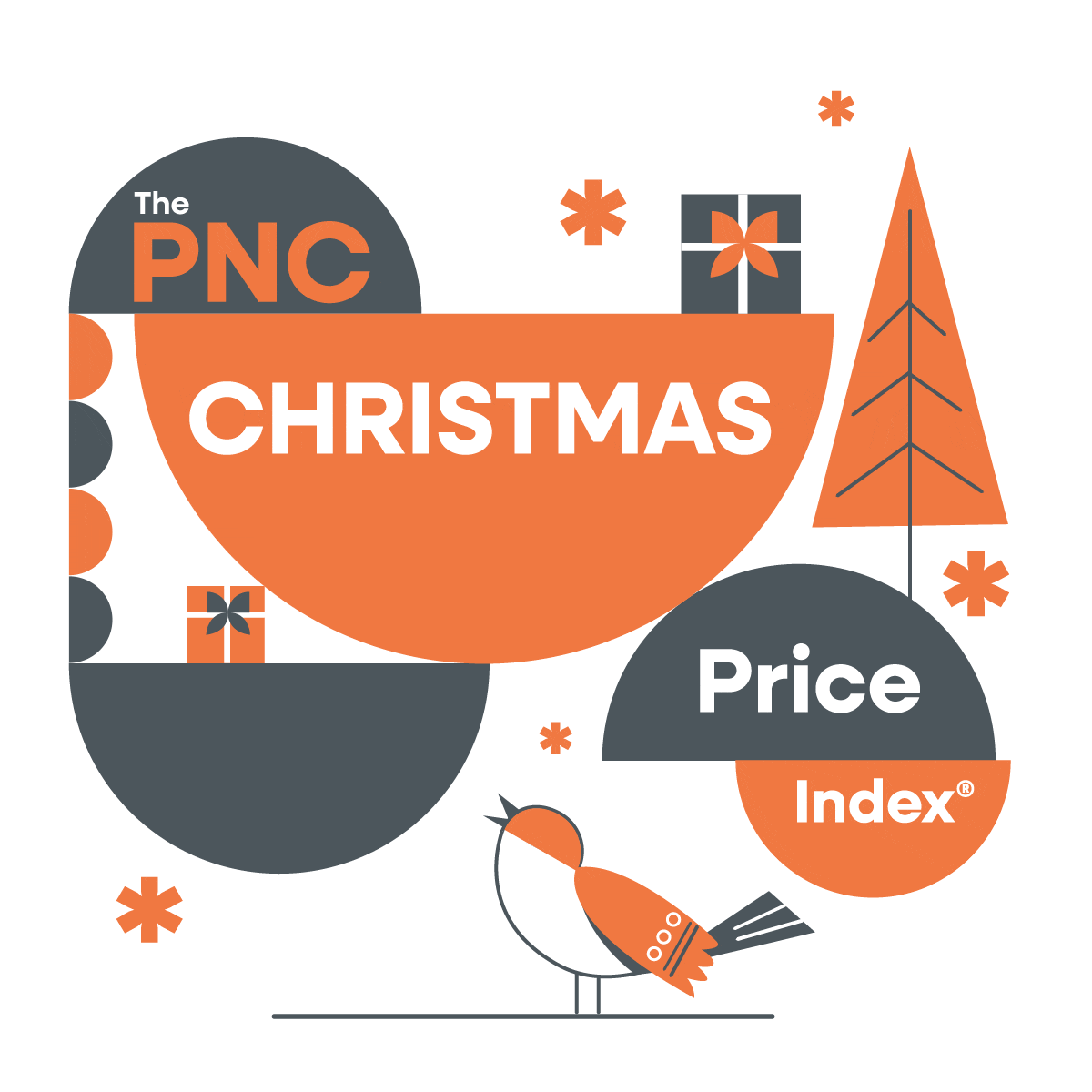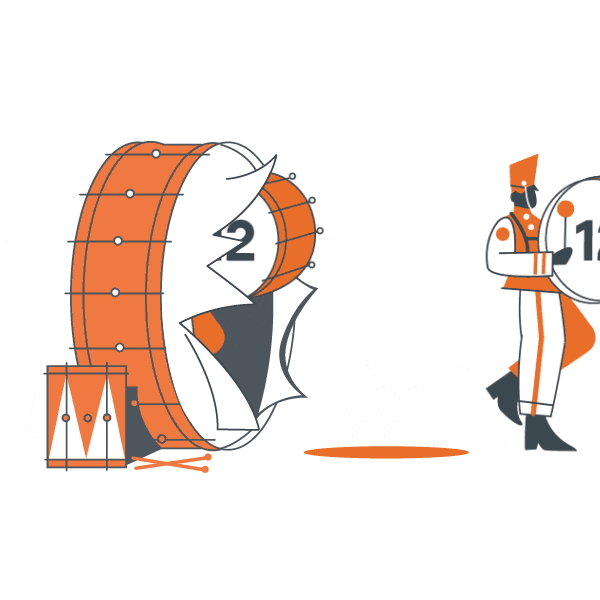"PNC Christmas Price Index" and "Christmas Price Index" are registered marks of The PNC Financial Services Group, Inc
The PNC Christmas Price Index
For 42 years, PNC has calculated the prices of the 12 gifts from the classic song, "The Twelve Days of Christmas." The PNC Christmas Price Index® remains a whimsical holiday tradition.



Total Christmas Price Index (CPI)
Even with its small basket of goods and services, the PNC Christmas Price Index is not immune to the rising costs in the broader U.S. economy, as measured by the Bureau of Labor Statistics’ Consumer Price Index.
$51,476.12
(+4.5%)
On the First Day of Christmas, My True Love Gave to Me...
A Partridge in a Pear Tree
$420.18
(+13.5%)
Buying a Partridge in a Pear Tree for your true love this year? You’ll pay 13.5% more for it than last year. But don’t blame the bird. Its pear tree home – impacted by land, labor and fertilizer costs – is entirely responsible for the growing price tag.







Two Turtle Doves
$750.00
(0.0%)
The Two Turtle Doves didn’t raise their price this year, but at $750 they’re still a surprisingly expensive gift on True Love’s list. It’s a good thing they prefer telephone wires to pear trees.


Three French Hens
$346.50
(0.0%)
The hens demanded a modest raise in 2024, but they’re status quo this year. They’re still $346.50 and still the cheapest group of birds True Love has to track down.




Four Calling Birds
$599.96
(0.0%)
If consistency were a virtue, these calling birds would be the most noble gift in the index. Their price hasn’t changed since 2014.


Five Gold Rings
$1,649.90
(+32.5%)
Inflation, Fed rate cut expectations and a declining U.S. dollar have sent investors racing for gold and other precious metals. The subsequent 32.5% increase in the price of the Five Gold Rings may have you racing to other options this holiday season.




Six Geese-A-Laying
$930.00
(+3.3%)
Geese are loud creatures – honking for all manner of reasons and likely no reason at all. That’s why their modest 3.3% increase feels so uncharacteristically quiet this year.



Seven Swans-A-Swimming
$13,125.00
(0.0%)
The swans had the decency not to raise their price in this economically turbulent year. They just weren’t decent enough to drop the $13,125 price tag or relinquish their spot as the most expensive group of birds in the index.




Eight Maids-A-Milking
$58.00
(0.0%)
Tied to the Federal Minimum Wage, the Eight Maids-a-Milking remain priced at $58 this year.



Nine Ladies Dancing
$8,856.88
(+3.5%)
Sometimes being third is great. Just ask the Nine Ladies Dancing, who keep raising their price – another 3.5% in 2025 – and their status as the third most expensive item on True Love’s shopping list.




Ten Lords-A-Leaping
$16,836.14
(+8.1%)
The lords leapt the swans as the most expensive gift in the index a few years back and apparently nobody told them there’s nobody left to leap. They’re tacking another 8.1% on True Love’s bill in 2025 as live entertainment costs continue to rise.



Eleven Pipers Piping
$3,797.48
(+2.2%)
If it’s cheap entertainment ideas you seek from the index, well, there are no options. But the Eleven Pipers Piping are the most affordable, with their price tag jumping just 2.2% this year due to the rising cost of performers.



Twelve Drummers Drumming
$4,106.08
(+2.2%)
Being the last item on the shopping list means sometimes you are forgotten. But we haven’t forgotten the drummers, and they haven’t forgotten to price in the increased cost of performers this year – another 2.2% in 2025.



True Cost of Christmas in Song
$218,542.98
(+4.4%)
This represents the total cost of all the gifts bestowed by True Love when you count each repetition of the song, totaling 364 presents. Spreading cheer throughout the year in 2025 costs 4.4% more than in 2024.
"Core" Index (Excluding Swans)
$38,351.12
(+6.1%)
This version of the CPI removes the most volatile gift from the index - the Swans-a-Swimming.
About the Index
The PNC Christmas Price Index® is an annual tradition which shows the current cost for one set of each of the gifts given in the song "The Twelve Days of Christmas."
It is similar to the U.S. Consumer Price Index, which measures the changing prices of goods and services like housing, food, clothing, transportation and more that reflect the spending habits of the average American.
The goods and services in the PNC Christmas Price Index® are far more whimsical, of course. And most years, the price changes closely mirror those in the U.S. Consumer Price Index.
It’s a fun way to measure consumer spending and trends in the economy. So, even if Pipers Piping or Geese-a-Laying didn’t make your gift list this year, you can still learn a lot by checking out why their prices have increased or decreased over the years.
All Gifts
| 1984-1993 | 1984 |
1985 |
1986 |
1987 |
1988 |
1989 |
1990 |
1991 |
1992 |
1993 |
|---|---|---|---|---|---|---|---|---|---|---|
| 1994-2003 | 1994 |
1995 |
1996 |
1997 |
1998 |
1999 |
2000 |
2001 |
2002 |
2003 |
| 2004-2013 | 2004 |
2005 |
2006 |
2007 |
2008 |
2009 |
2010 |
2011 |
2012 |
2013 |
| 2014-2023 | 2014 |
2015 |
2016 |
2017 |
2018 |
2019 |
2020 |
2021 |
2022 |
2023 |
| 2024-2025 | 2024 |
2025 |
What’s the difference between the Total Cost of Christmas and the True Cost of Christmas? Who figures out the prices for the PNC Christmas Price Index? The answers to all these questions and more can be found here.
What is the Christmas Price Index®, anyway?
The PNC Christmas Price Index (PNC CPI) shows the current cost for one set of each of the gifts given in the song, “The Twelve Days of Christmas."
What is the "True Cost of Christmas?"
The True Cost of Christmas is the cumulative cost of all the gifts when you count each repetition in the song, reflecting the cost of 364 gifts. This cost has measured even wider fluctuations over the years.
Why did PNC start tabulating the Christmas Price Index®?
It all started 42 years ago as a way to engage clients of PNC’s predecessor, Provident National Bank in Philadelphia, during the traditionally light holiday weeks. What hatched as the creative brainchild of the bank’s then-chief economist has since grown into one of PNC’s most popular and anticipated economic reports.
Who is the holiday shopper at PNC?
Since 1986, Rebekah McCahan of PNC Asset Management Group's Investment Office has handled our shopping duties, putting a price tag on French hens, maids-a-milking, gold rings and all the other items in the PNC CPI. She has evaluated some distinctive economic trends along the way.
Where does McCahan do her shopping?
The partridge and dove prices came from a national bird supplier. Hatcheries provided the cost of the hens and swans. The price of the geese came from a waterfowl farm. A national pet chain provided the price of the calling birds, or canaries. The pear tree price came from a Pennsylvania nursery. A national jewelry chain provided the cost of five 14-carat gold rings, and PHILADANCO, a modern dance company in Philadelphia, offered the price of ladies dancing, while Philadelphia Ballet supplied the cost of the Lords-a-Leaping. Maids-a-milking are the only unskilled laborers in the PNC CPI and, as such, they reflect the federal minimum wage. Year after year, the sources for the prices remain the same for the most part for consistency, but they have changed on occasion due to changes in the market or business landscape.
What has changed since 1984?
Many things. First, the Internet. Today, it’s easier for us to find the goods and services listed in the song online. This convenience comes at a price, however: goods and services from the survey that are purchased online tend to be more expensive than those purchased in a more traditional transaction, mainly due to added shipping and handling costs of the specialty items. In 2015, we adjusted the current prices of the turtle doves and swans to better reflect open market pricing, and revised the historical data to correlate. Second, over the last 40 years, the price of services in general has increased, while the price of goods has slowed. In the 1984 PNC CPI, goods were by far the more expensive component of the Index — today it’s services. Since 1984, the PNC CPI has increased 133%. Also related to services, in 2007, federal laws increased the minimum wage and gave the maids-a-milking their first raise since 1997. The wage increased again in both 2008 and 2009, and is now holding steady at $7.25 per hour. Third, fuel costs. As fuel prices go up and down, they have a major effect on the cost of shipping.
In which year could a shopper afford to be a scrooge?
The cheapest PNC Christmas Price Index® in dollars occurred in 1995, when the cost of Christmas was just under $17,848.99[1].
In 2021, why did PNC compare data with 2019 and not 2020?
Comparing 2019 data was a better gauge of the impacts of inflation before the pandemic’s effects took hold of the global economy. We "normalized" the comparison by excluding a-once-in-a-century pandemic that had an outsized impact on 2020's data.
Why did the 2020 CPI change so drastically?
Taking into account the impact of social distancing, PNC calculated the 2020 price tag for the PNC CPI at just $16,168.10, a considerable decrease of $22,825.45 or -58.5% from the 2019 cost, with a third of the index constituents literally not available for purchase. The biggest impact was for live performances, which were mostly unavailable. While some performing arts groups found ways to engage, such as through virtual presentations, it was a silent night at most symphonies and the lights dimmed on many dance companies, as reflected in 2020’s significant drop in PNC’s CPI data.

